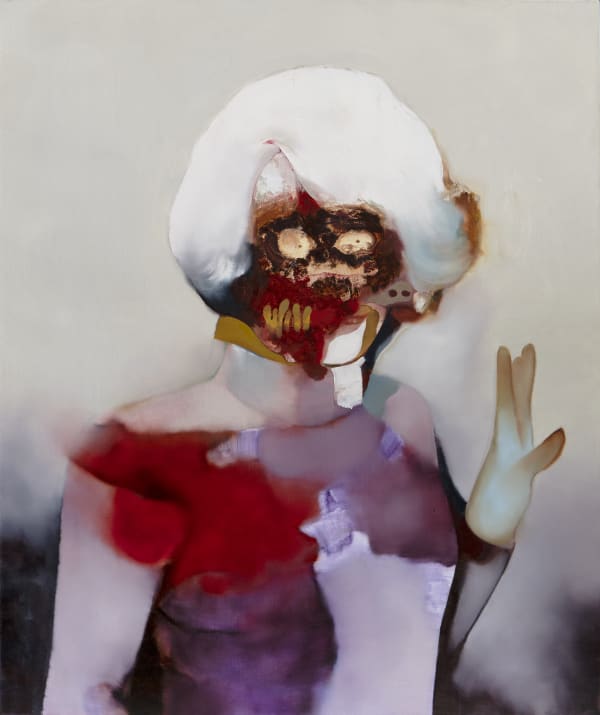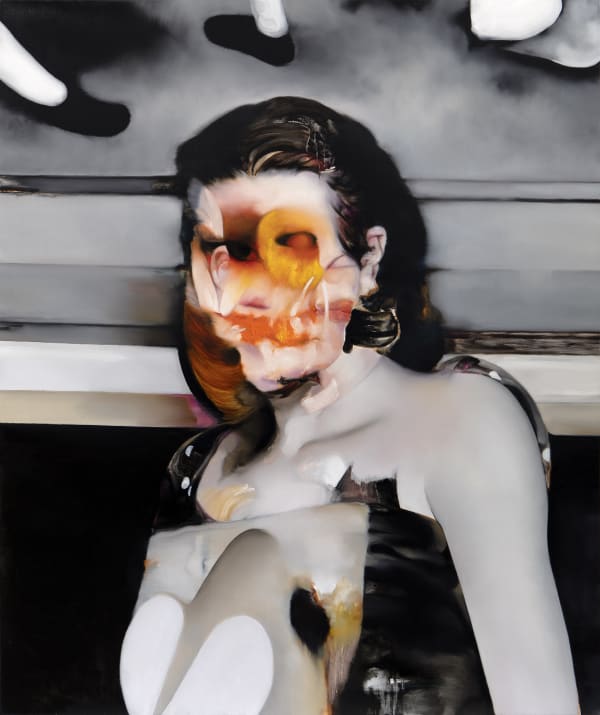PORTRAITS: He Wei
PRIMO MARELLA GALLERY LUGANO
__________________________________
Who hasn't ever heard of the “Picture of Dorian Gray”?
Who has never imagined this dismal and macabre deterioration of the soul recreated in a work of art?
How much we would like to be able to talk to Dorian, at the end of his long journey in the most dissolute and corrupted aesthetics, to understand how this research for a theatrical image of the self towards perfection, ends up disintegrating in front of the Art that reconfigures and reflects a disheartening reality?
Analysis and decomposition of the portrait are the basis of this new production by He Wei.
Dorian Gray from contemporaneity who crumble before the artist's gaze. A gaze that embrace their true form. Dorian Gray who have tried, in their aim for existence and its relief, the contemporary ways of drugs. To ease the distress of being and the inability to maintain a definitive contact with an elusive reality, ever more rapid and changeable.
There is an underlying ambiguity in these paintings.
They have a curative, positive function: they are medicines, for a distorted reality.
But we cannot forget that they are, and will always be, a true representation of this reality: current portraits of a complex and disadvantaged human being, who needs to rebalance, through drugs, an excess of psychosis and schizophrenia.
“Chemicals are an important constituent for the life of human beings.
They are origin. They are the fundament of the natureatmolecular level and, as such, they are a direct challenge to theology. They dominate the physical body and, incredibly, produce consciousness and spirit.
Psychiatric drugs are man-made. They are different from medicines to heal the human body.
Psychiatric medications cause effects similar to human emotions and can dominate conscious behavior.They heal the human soul.
They are a sort of second structure of our chemical composition capable of generating or altering various types of emotions.But the titles do not explain the works, instead it is more like a relationship of editing between the work and the name of the psychiatric drug associated with it. "
(He Wei)
Unlike his previous canvases, characterized by the cancellation of the face through graffiti and colored geometric shapes, the new works are composed of very strong and incisive colors, oil stains, studied and skillful brushstrokes.
He Wei, with no needs of words, accompanies us through his chaotic vision of human interiority. With shapes, colors, shades. With memories of anatomical elements, transplanted into uncanny positions. Pestering our perception.
The works embody, perhaps for the first time, the artist's true inner elaboration of the subjects represented.
Crossing this last pictorial cycle, from work to work, we follow a path, a path of growth, a description of the human depths.
This passage is produced first by the illusion of working with chemical elements - the artist deceit us with the use of substances suitable for the dissolution of the painting - giving the idea of stripping off the figures, almost to cancel the human appearance, or rather, to brutally and violently flay it, in order to reach the inner substance of these subjects, their intrinsic essence.
Arriving - with the latest works - at an emblematic situation: there is no more need to eviscerate, there is no longer a need to mutilate and tear the human body, to reach the conscience of the subject.
It is consciousness itself that emanates, that transpires from the portrait.
No more digging deeply, but surfacing.
Irradiation of the subject's psychotic essence.
No longer the container, but the content.
These paintings - originally sublimated as a physical representation to determine the individual - are no longer figuration of real people, but of consciousness, portraits of the transcendental self of the subjects.
We find dysfunctional elements combined together, a profound work of psycho-investigation of the figure, effigies of psycho-perception, as far as there is from the photographic portrait.
Wei personifies the inner essence of his subjects, and not their aesthetic image.
They are human, they are alive, they are individuals like each of us, but seen from the inside, indeed, it is the interiority itself that emanates its own figure, its shades and its colors.
The portrait is nebulized, as if a layer of haze allows us to shield the exterior to expose the interior to the world: the psycho-attitude of these subjects, the brutality, the animality, cruelty and hypocrisy, every aspect that we, as conscious human beings, try to hide. Every concealed corner of the soul, from the brightest to the most rugged, substitutes the portrait as an aesthetic reproduction of the subject as an individual.
The artist tells to the world new stories, stories of fears, distant and very close. Wei shows us, with a violent act, the fear of revealing to the other what we have inside, our most secret truth.
What is this if not the cruellest way of being laid bare, a snapshot of the inner human brutality, which in this case becomes a portrait?
In the book “Filosofia e Antropologia del Ritratto”, Roberto Terrosi refers to a current historical situation in which "the transcendental constitution of the visual ego is made up of a priori rationality and indefinite emotions and thus begins a work of definition of himself no longer through the external aspect (the “outside”) of this empirical-transcendental “homo”, traditionally represented by the face, but through the presumed manifestation of his “inside”. [...] This opens an era without portraits, but which actually subsumes all possible forms in the name of the internal portrait of Man".
The philosopher thus refers to various types of painting between the representation of purely rational forms and the representation of emotional components, drives and neuroses, ranging from abstractionism, supremacism and neoplasticism, for the first case, to expressionism and surrealism for the second one.
While in reality "the representation of the subject in its singularity is still missing, as it is stretched between abstraction and pre-categoriality".
We can say that He Wei, at this point of his artistic career, not only has reached this state of representation of the subject, but has even surpassed it.
-

He Wei
Thioridazine 2020
Oil on canvas
120 x 100 cm
-

He Wei
Fluphenazine 2020
Oil on canvas
120 x 100 cm
-

He Wei
Risperidone 2020
Oil on canvas
120 x 100cm
-

He Wei
Valproic acid 2021
Oil on canvas
160 × 130 cm
-

He Wei
Clozapine 2021
Oil on canvas
120 x 100 cm
-

He Wei
Clonazepam 2021
Oil on canvas
120 x 100 cm
-

He Wei
Ziprasidone 2021
Oil on canvas
120 x 100 cm
-

He Wei
Olanzapine 2021
Oil on canvas
120 x 100 cm














